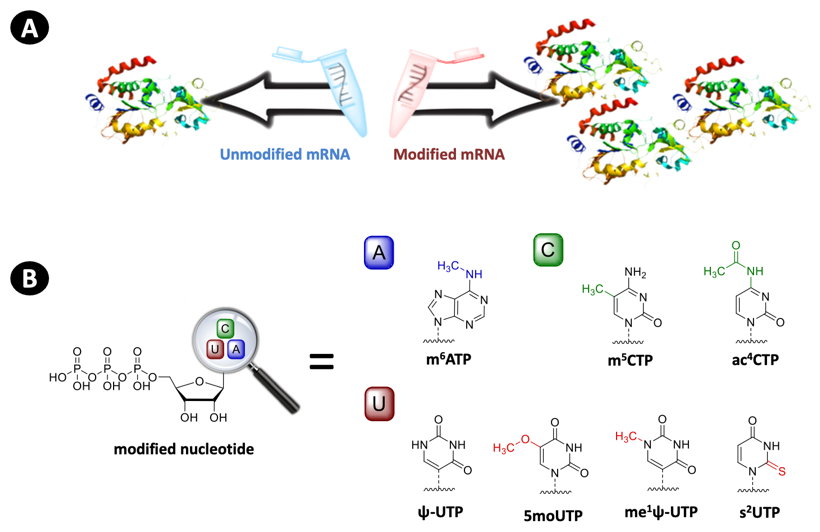Your Basket/Online Quote
Items: 2 (239,80 €)
» Search & Order
» Sign in / Register
Your Basket/Online Quote
Items: 2 (239,80 €)
» Search & Order
» Sign in / Register
5’-capping and nucleoside base modifications significantly increase translation efficiency while reducing immunogenicity of synthetic mRNA (Fig. 1)[1-16].
Such modifications are conveniently introduced by correspondingly modified nucleotides via T7 RNA polymerase-mediated in vitro transcription (Fig. 1B, Tab. 1).

Figure 1: Nucleoside base modifications are required for optimal synthetic mRNA functionality.
A) Nucleoside base modifications increase mRNA translation efficiency.
B) Nucleoside base modified triphosphates are excellent enzymatic substrates (A: adenine, C: cytosine, U: uracil).
The optimal combination of 5’ capping and nucleoside base modification(s) however, needs to be individually determined for each mRNA target.
[1] Karikó et al. (2005) Suppression of RNA Recognition by Toll-like Receptors: The Impact of Nucleoside Modification and the Evolutionary Origin of RNA. Immunity 23:165.
[2] Karikó et al. (2008) Incorporation of Pseudouridine into mRNA Yields Superior Nonimmunogenic Vector With Increased Translational Capacity and Biological Stability. Mol. Ther. 16 (11):1833.
[3] Kormann et al. (2011) Expression of therapeutic proteins after delivery of chemically modified mRNA in mice. Nature Biotechnology 29 (2):154.
[4] Warren et al. (2011) Highly Efficient Reprogramming to Pluripotency and Directed Differentiation of Human Cells with Synthetic Modified mRNA. Cell Stem Cell 7:618.
[5] Svitkin et al. (2017) N1-methyl-pseudouridine in mRNA enhances translation through eIF2alpha-dependent and independent mechanisms by increasing ribosome density. Nucleic Acid Res 45 (10):6023.
[6] Andies et al. (2015) N1-methylpseudouridine-incorporated mRNA outperforms pseudouridine-incorporated mRNA by providing enhanced protein expression and reduced immunogenicity in mammalian cell lines and mice. J. Control. Release 217:337.
[7] Li et al. (2016) Effects of Chemically Modified Messenger RNA on Protein Expression. Bioconjugate Chem. 27:849.
[8] Arango et al. (2018) Acetylation of Cytidine in mRNA Promotes Translation Efficiency. Cell 175 (7):1872.
[9] Sinclair et al. (2017) Profiling Cytidine Acetylation with Specific Affinity and Reactivity. ACS Chem. Neurosci. 12 (12):2922.
[10] Dominissini et al. (2016) The dynamic N1-methyladenosine methylome in eukaryotic messenger RNA. Nature 530:441.
[11] Wienert et al. (2018) In vitro transcribed guide RNAs trigger an innate immune response via RIG-I pathway. PLoS Biol. 16 (7):e2005840.
[12] Kim et al. (2018) CRISPR RNAs trigger innate immune responses in human cells. Genome Res. 28 (3):367.
[13] Badieyan et al. (2019) Concise Review: Application of Chemically Modified mRNA in Cell Fate Conversion and Tissue Engineering. Stem Cells Translational Medicine 8:833.
[14] Hadas et al. (2019) Optimizing Modified mRNA In Vitro Synthesis Protocol for Heart Gene Therapy. Molecular Therapy: Methods & Clinical Development 14:300.
[15] Shatkinet al. (1976) Capping of eukaryotic mRNAs. Cell 9 (4):645.
[16] Gallowayet al.(2019) mRNA cap regulation in mammalian cell function and fate. Biochimica et Biophysica Acta 1862 (3):270.